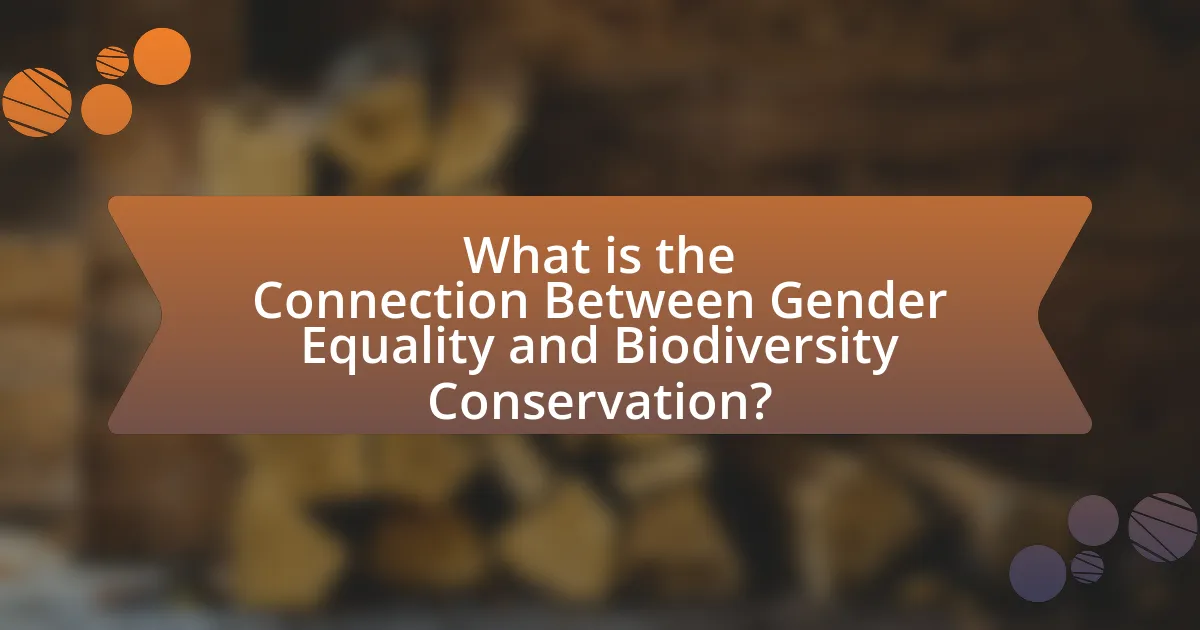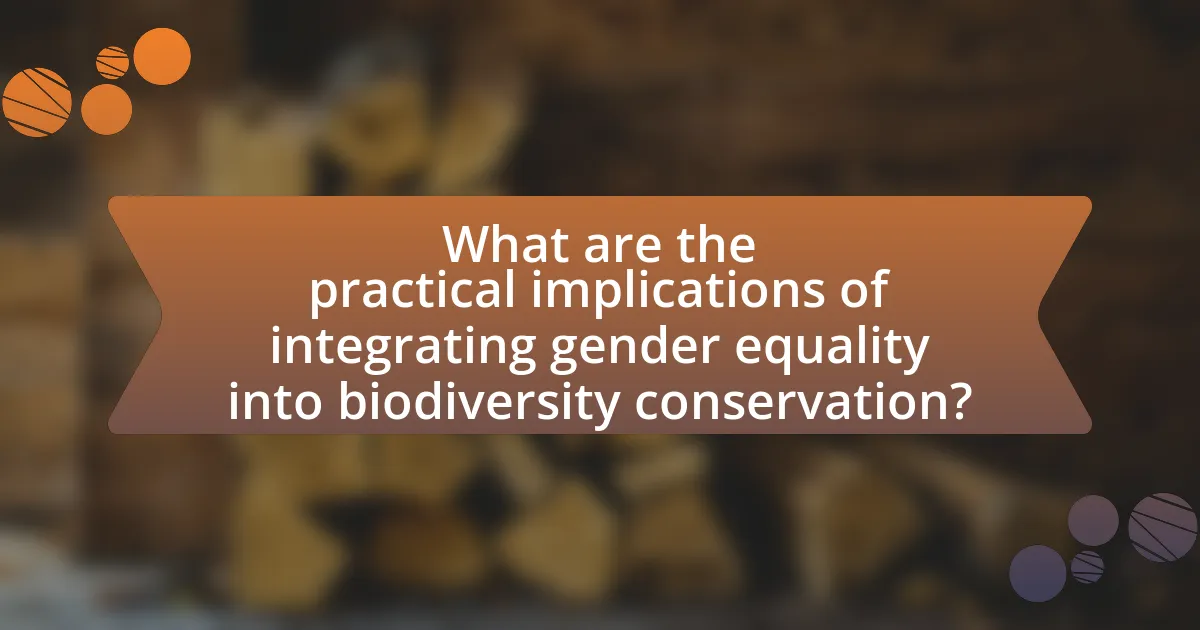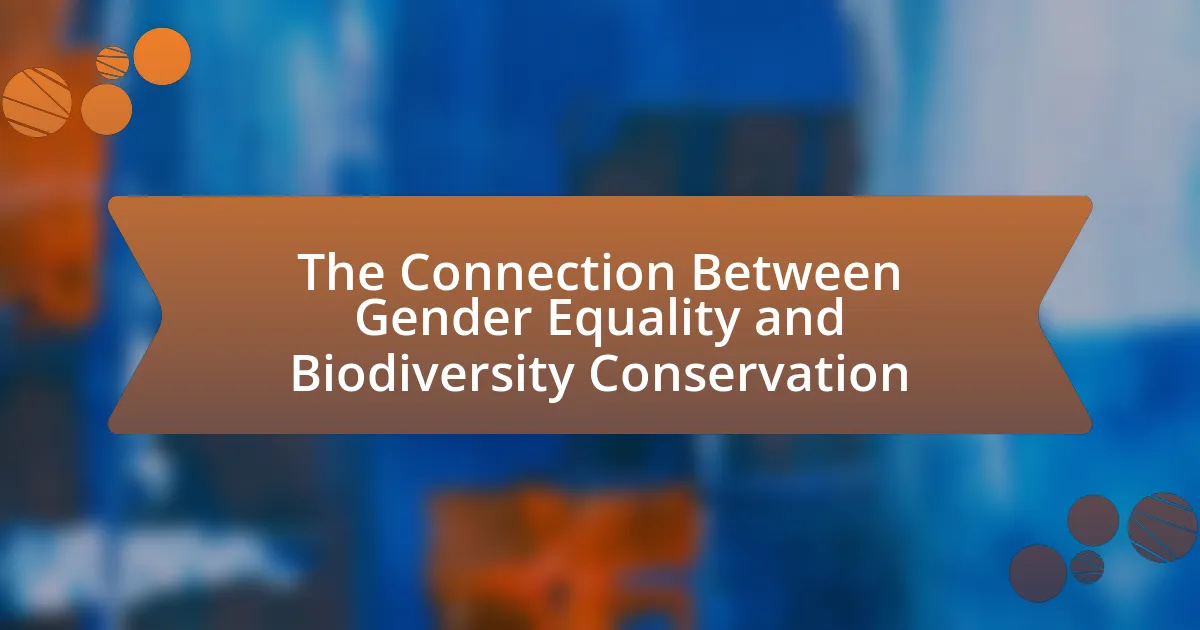The article explores the critical connection between gender equality and biodiversity conservation, emphasizing that empowering women enhances environmental management and conservation outcomes. It highlights research indicating that women’s involvement in natural resource management leads to increased agricultural productivity and improved biodiversity through sustainable practices. The article discusses how gender roles influence conservation efforts, provides specific examples of successful women-led initiatives, and examines the cultural and institutional challenges women face in conservation roles. It concludes by outlining strategies for promoting gender equality in biodiversity initiatives, emphasizing the importance of inclusive policies and community engagement for effective conservation.

What is the Connection Between Gender Equality and Biodiversity Conservation?
Gender equality and biodiversity conservation are interconnected as empowering women leads to more effective environmental management. Research indicates that women often play crucial roles in natural resource management and conservation efforts, particularly in rural communities where they are primary caregivers and resource users. For instance, a study by the Food and Agriculture Organization (FAO) found that when women have equal access to resources and decision-making, agricultural productivity can increase by 20-30%, which directly impacts biodiversity through sustainable practices. Furthermore, gender-inclusive policies enhance community resilience to environmental changes, thereby supporting biodiversity conservation efforts.
How do gender roles influence biodiversity conservation efforts?
Gender roles significantly influence biodiversity conservation efforts by shaping the participation and decision-making processes of different genders in environmental management. Women often play crucial roles in local biodiversity conservation due to their traditional knowledge and practices related to resource management, which can enhance conservation outcomes. For instance, studies have shown that women’s involvement in community-based conservation initiatives leads to more sustainable practices, as they tend to prioritize long-term ecological health over short-term economic gains. Furthermore, gender-inclusive policies have been linked to improved biodiversity outcomes, as they ensure diverse perspectives and expertise are integrated into conservation strategies. Research by the United Nations Environment Programme indicates that gender equality in environmental governance can lead to more effective conservation efforts, highlighting the importance of addressing gender roles in biodiversity initiatives.
What specific examples illustrate the impact of gender roles on conservation?
Gender roles significantly impact conservation efforts, as evidenced by the involvement of women in community-based resource management. For instance, in Nepal, women’s participation in forest management has led to improved biodiversity outcomes, with studies showing that areas managed by women-led groups have higher tree density and species diversity compared to those managed by men. Additionally, in Tanzania, women’s roles in sustainable fishing practices have resulted in better fish stock recovery, demonstrating that gender-inclusive approaches enhance conservation effectiveness. These examples illustrate that empowering women in conservation roles not only addresses gender inequality but also contributes to more successful environmental management.
How do cultural perceptions of gender affect conservation practices?
Cultural perceptions of gender significantly influence conservation practices by shaping the roles and responsibilities assigned to men and women in environmental management. In many societies, traditional gender roles dictate that men are primarily responsible for resource extraction, while women often manage household resources and biodiversity. This division can lead to a lack of recognition for women’s contributions to conservation, as seen in studies indicating that women’s knowledge of local ecosystems is frequently undervalued. For instance, research by the Food and Agriculture Organization highlights that empowering women in conservation efforts can enhance biodiversity outcomes, as women often possess unique insights into sustainable practices. Therefore, addressing cultural perceptions of gender is crucial for effective conservation strategies that leverage the strengths of both genders.
Why is gender equality important for effective biodiversity conservation?
Gender equality is crucial for effective biodiversity conservation because it enhances decision-making processes and resource management. Women often play a significant role in natural resource management and possess unique knowledge about local ecosystems. Studies show that when women are included in conservation efforts, there is a higher likelihood of successful outcomes, as evidenced by research from the World Bank, which indicates that gender-inclusive policies can lead to improved environmental sustainability. Furthermore, gender equality fosters diverse perspectives, leading to more innovative solutions for biodiversity challenges.
What evidence supports the link between gender equality and conservation outcomes?
Research indicates that gender equality positively influences conservation outcomes by enhancing community engagement and resource management. For instance, a study published in “Nature Sustainability” by D. A. B. B. et al. (2020) found that communities with higher gender equality demonstrated improved biodiversity conservation practices, as women often play crucial roles in sustainable resource management. Additionally, the World Bank reported that empowering women in agricultural practices leads to increased productivity and better environmental stewardship, which directly correlates with successful conservation efforts. These findings underscore the importance of integrating gender equality into conservation strategies to achieve more effective and sustainable outcomes.
How does empowering women contribute to biodiversity preservation?
Empowering women contributes to biodiversity preservation by enhancing their roles in sustainable resource management and conservation efforts. Women often possess traditional ecological knowledge that is crucial for maintaining biodiversity, as they are frequently responsible for managing local resources such as water, forests, and agricultural practices. Studies show that when women are involved in decision-making processes regarding environmental management, there is a significant increase in the effectiveness of conservation strategies. For instance, research published in the journal “Nature” indicates that communities with higher female participation in environmental governance experience better biodiversity outcomes. This correlation underscores the importance of gender equality in fostering sustainable practices that protect ecosystems.

What are the challenges in achieving gender equality in conservation?
Achieving gender equality in conservation faces several challenges, including systemic discrimination, lack of access to resources, and insufficient representation in decision-making processes. Systemic discrimination often manifests in cultural norms that prioritize male leadership and limit women’s roles in conservation efforts. Additionally, women frequently encounter barriers to accessing land, funding, and training, which are essential for effective participation in conservation initiatives. Furthermore, women’s voices are often underrepresented in policy-making, leading to a lack of consideration for gender-specific needs and perspectives in conservation strategies. These challenges hinder the effectiveness of conservation efforts and perpetuate inequalities, as evidenced by studies showing that gender-inclusive approaches can enhance biodiversity outcomes.
What barriers do women face in biodiversity conservation roles?
Women face significant barriers in biodiversity conservation roles, including limited access to resources, lack of representation in decision-making processes, and cultural norms that restrict their participation. Research indicates that women often have less access to land, credit, and technology, which hinders their ability to engage effectively in conservation efforts. Additionally, a study by the Food and Agriculture Organization (FAO) highlights that women are underrepresented in leadership positions within environmental organizations, which limits their influence on policies that affect biodiversity. Cultural attitudes in many societies also perpetuate gender stereotypes, further marginalizing women’s contributions to conservation initiatives.
How do socio-economic factors limit women’s participation in conservation?
Socio-economic factors significantly limit women’s participation in conservation by restricting their access to resources, education, and decision-making roles. Women often face barriers such as lower income levels, lack of property rights, and limited access to financial services, which hinder their ability to engage in conservation activities. For instance, a study by the Food and Agriculture Organization (FAO) found that women in rural areas are less likely to own land, which restricts their involvement in sustainable land management practices. Additionally, cultural norms and gender roles can further marginalize women, preventing them from participating in community conservation initiatives. These socio-economic constraints create a cycle where women’s contributions to biodiversity conservation are undervalued and overlooked, ultimately impacting the effectiveness of conservation efforts.
What institutional challenges hinder gender equality in conservation efforts?
Institutional challenges that hinder gender equality in conservation efforts include a lack of representation of women in decision-making roles, insufficient funding for gender-focused initiatives, and the persistence of gender biases within organizational cultures. Research indicates that women are often underrepresented in leadership positions in conservation organizations, which limits their influence on policies and practices that promote gender equality. Additionally, funding mechanisms frequently prioritize projects without a gender lens, resulting in inadequate support for initiatives that address the specific needs and contributions of women in conservation. Furthermore, entrenched gender biases can lead to discriminatory practices and policies that marginalize women’s voices and participation in conservation efforts.
How can these challenges be addressed to improve gender equality?
To address challenges and improve gender equality, implementing policies that promote equal access to education and resources for women is essential. Research shows that when women have equal educational opportunities, they contribute significantly to biodiversity conservation efforts, as seen in various community-led conservation projects globally. For instance, a study by the Food and Agriculture Organization highlights that women play a crucial role in sustainable agricultural practices, which directly impacts biodiversity. Additionally, enforcing legal frameworks that protect women’s rights and promote their participation in decision-making processes can further enhance gender equality and, consequently, biodiversity conservation.
What strategies have proven effective in promoting gender equality in conservation?
Effective strategies for promoting gender equality in conservation include implementing gender-responsive policies, enhancing women’s participation in decision-making processes, and providing targeted training and resources for women in conservation roles. Gender-responsive policies ensure that conservation initiatives consider the specific needs and contributions of women, leading to more equitable outcomes. Increasing women’s participation in decision-making processes has been shown to improve project effectiveness and sustainability, as evidenced by studies indicating that diverse leadership teams yield better conservation results. Additionally, targeted training programs equip women with the necessary skills and knowledge, fostering their empowerment and enabling them to take on leadership roles in conservation efforts.
How can policy changes support gender equality in biodiversity initiatives?
Policy changes can support gender equality in biodiversity initiatives by ensuring equal access to resources, decision-making processes, and capacity-building opportunities for women. For instance, implementing gender-responsive policies can lead to the inclusion of women in conservation efforts, which is crucial as women often play a significant role in managing natural resources. Research indicates that when women are involved in biodiversity management, it can enhance conservation outcomes and improve community resilience. A study by the Food and Agriculture Organization (FAO) highlights that gender equality in agricultural practices leads to increased productivity and sustainability, demonstrating the positive impact of inclusive policies on biodiversity initiatives.

What are the practical implications of integrating gender equality into biodiversity conservation?
Integrating gender equality into biodiversity conservation leads to enhanced conservation outcomes and improved community resilience. Gender equality ensures that both men and women contribute to and benefit from conservation efforts, which can result in more effective resource management. For instance, studies show that women often possess unique knowledge about local ecosystems, which can enhance biodiversity strategies. Furthermore, organizations like the United Nations Environment Programme highlight that gender-inclusive policies can lead to better decision-making processes and increased participation in conservation initiatives, ultimately fostering sustainable practices that benefit both biodiversity and local communities.
How can organizations implement gender-sensitive approaches in conservation?
Organizations can implement gender-sensitive approaches in conservation by integrating gender analysis into their project planning and execution. This involves assessing the different roles, responsibilities, and needs of men and women in relation to biodiversity and natural resource management. For instance, the Food and Agriculture Organization (FAO) emphasizes that understanding gender dynamics can enhance conservation outcomes by ensuring that both women’s and men’s knowledge and practices are recognized and utilized. Additionally, organizations can provide training and capacity-building programs tailored to women, enabling their active participation in conservation efforts. Research shows that when women are involved in decision-making processes, conservation initiatives are more effective, as evidenced by case studies in community-managed forests in Nepal, where women’s involvement led to improved biodiversity outcomes.
What best practices should be adopted for gender integration in conservation projects?
Best practices for gender integration in conservation projects include ensuring equal participation of women and men in decision-making processes, conducting gender analyses to understand specific needs and roles, and providing gender-sensitive training and capacity-building initiatives. Research indicates that projects that actively involve women in conservation efforts lead to more sustainable outcomes, as women often possess unique knowledge about local ecosystems. For instance, a study by the Food and Agriculture Organization found that gender-inclusive approaches can enhance biodiversity conservation by leveraging women’s traditional ecological knowledge.
How can monitoring and evaluation frameworks include gender considerations?
Monitoring and evaluation frameworks can include gender considerations by integrating gender-disaggregated data and gender-sensitive indicators into their design and implementation. This approach ensures that the specific needs, roles, and contributions of different genders are recognized and assessed. For instance, the United Nations Development Programme emphasizes the importance of collecting data that reflects gender differences in access to resources and decision-making power, which can inform more equitable conservation strategies. By applying gender analysis throughout the evaluation process, frameworks can better capture the impact of biodiversity conservation efforts on various gender groups, ultimately leading to more effective and inclusive outcomes.
What role do community engagement and education play in this integration?
Community engagement and education are crucial in integrating gender equality with biodiversity conservation by fostering awareness and participation among local populations. Engaging communities ensures that diverse perspectives, particularly those of women, are included in conservation efforts, leading to more effective and sustainable outcomes. Education empowers individuals with knowledge about the interdependence of gender equality and biodiversity, promoting practices that support both social equity and environmental health. Research indicates that when women are actively involved in conservation initiatives, such as in the case of the Women’s Environment and Development Organization, biodiversity outcomes improve significantly, demonstrating the effectiveness of inclusive approaches.
How can awareness campaigns promote gender equality in conservation?
Awareness campaigns can promote gender equality in conservation by educating communities about the critical role women play in biodiversity management and decision-making processes. These campaigns highlight the contributions of women in sustainable practices, thereby challenging stereotypes and fostering inclusive participation. For instance, research by the Food and Agriculture Organization indicates that empowering women in agriculture leads to increased productivity and improved conservation outcomes. By raising awareness of these facts, campaigns can mobilize support for policies that promote gender equity, ultimately enhancing conservation efforts and biodiversity preservation.
What educational programs can empower women in biodiversity conservation?
Educational programs that can empower women in biodiversity conservation include community-based training initiatives, formal education in environmental science, and leadership development programs focused on conservation. Community-based training initiatives, such as those offered by organizations like Women for Wildlife, provide hands-on experience in local biodiversity projects, enhancing women’s skills and confidence in conservation efforts. Formal education programs, such as degrees in environmental science or ecology, equip women with the scientific knowledge necessary to engage in biodiversity conservation effectively. Leadership development programs, like the Women in Conservation Leadership program, focus on building leadership skills among women, enabling them to take on influential roles in conservation policy and practice. These educational programs collectively contribute to increasing women’s participation and effectiveness in biodiversity conservation efforts.
What are the key takeaways for promoting gender equality in biodiversity conservation?
Key takeaways for promoting gender equality in biodiversity conservation include integrating women’s participation in decision-making processes, recognizing the role of women in sustainable resource management, and ensuring equitable access to resources and benefits. Research indicates that when women are involved in conservation efforts, biodiversity outcomes improve; for instance, a study published in “Nature” by D. J. Leisher et al. (2016) found that projects with female leadership had a higher success rate in biodiversity conservation. Additionally, addressing gender-specific barriers and providing education and training can empower women, leading to more effective conservation strategies.
